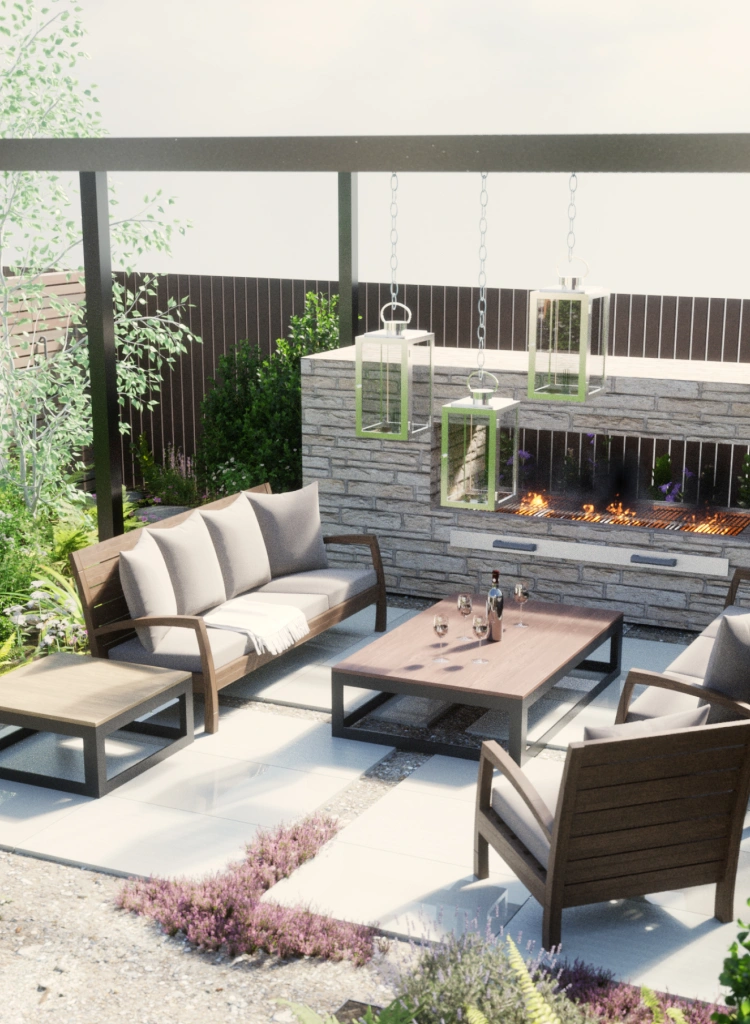
Garden Design Edinburgh: Crafting Your Ideal Outdoor Space
Did you know that 85% of homeowners believe a well-designed garden with a manicured lawn and attractive borders can increase house and site value by up to 20%? In the heart of Edinburgh, where historic charm meets modern living, your garden isn’t just an outdoor area; it’s a canvas waiting to be transformed with a lush lawn, vibrant borders, and a personal nick. Whether you’re dreaming of a serene green oasis or a vibrant floral paradise, tapping into professional garden design services in Edinburgh is your ticket to creating an enchanting outdoor retreat that reflects your personality and lifestyle. Forget the one-size-fits-all approach—let’s dive into how tailored garden design can turn your backyard dreams into reality, making every inch count.
Unique Aspects of Edinburgh’s Garden Design
Cobblestone Paths
Edinburgh’s garden design stands out for its historic cobblestone paths. These pathways add a timeless charm and character to gardens. They guide visitors through lush greenery in the city garden, connecting different sections seamlessly, as garden consultant Nick advises.
Cobblestone paths are durable and weather-resistant. This makes them perfect for Edinburgh’s variable climate. Their uneven surface and varied colours blend well with the natural landscape of the city garden, creating a rustic feel that Nick, the garden consultant, appreciates.
Native Plants
Incorporating native Scottish plants is key in Edinburgh’s garden design. This approach ensures authenticity while supporting local biodiversity. Native plants like rowan, birch, and Scots pine thrive here.
Using native species has several benefits:
- They’re adapted to the local climate.
- They require less water and maintenance.
- They provide habitats for native wildlife.
Gardens featuring these plants reflect Scotland’s natural beauty within urban spaces.
Serene Spaces
Creating serene, green spaces amidst urban architecture is a priority in Edinburgh’s garden design. These areas, often designed by garden consultants, offer residents and visitors a peaceful retreat from city life. Gardens often feature open lawns, shaded seating areas, and tranquil water features.
The contrast between historic buildings and lush gardens enhances both elements’ beauty:
- The greenery softens the harsh lines of urban structures.
- Architectural elements frame nature scenes uniquely.
Climate Considerations for Local Flora
Resilient Plants
Selecting plants that can withstand Edinburgh’s unpredictable weather is crucial. The city experiences a mix of rain, wind, and occasional sunshine. Gardeners must choose flora that thrive in these conditions.
For instance, native species like the Scottish thistle and heather are excellent choices. They’re adapted to the local climate and require less maintenance. Non-native but resilient plants, such as lavender and some types of sedum, also perform well.
Drainage Solutions
Edinburgh’s wet climate makes proper garden drainage essential. Without it, water can pool and damage plant roots or lead to soil erosion.
There are several effective solutions for this issue. Installing French drains or using permeable paving materials helps manage excess water. Raised beds also offer an attractive way to improve drainage while adding structure to your garden design.
Microclimate Utilisation
Every garden has microclimates—small areas with slightly different environmental conditions than the rest of the space. Recognising and utilising these zones allows for greater plant diversity in your Edinburgh garden.
For example:
- Sheltered spots near walls might support plants that need protection from wind.
- Sunny patches could be ideal for sun-loving herbs like rosemary.
Architectural Harmony in Garden Layouts
Historical Alignment
Aligning garden design with Edinburgh’s Georgian and Victorian architecture is crucial. This ensures the outdoor space complements the city’s rich history. Architects often draw inspiration from these eras to create a seamless transition between house and garden.
The use of traditional stonework in modern designs bridges past and present. It adds character to new constructions while honouring Edinburgh’s architectural heritage. Stones sourced locally can be used for walls, paths, or borders, adding a sense of place.
Modern Balance
Balancing soft planting with hard landscaping features is key in creating harmonious gardens. This approach caters to both aesthetic appeal and practicality. Soft planting brings colour, texture, and life to an area. It attracts wildlife and promotes biodiversity.
Hard landscaping elements like patios or courtyards define spaces within the garden. They offer structure around which plants can thrive. Incorporating both aspects thoughtfully results in a balanced outdoor space that feels both inviting and organised.
- Pros:
- Enhances visual appeal
- Supports local wildlife
- Increases property value
- Cons:
- Requires careful planning
- May need ongoing maintenance
Consultation and Design Process Overview
Initial Visit
The journey to a bespoke garden starts with an initial site visit. Here, designers grasp the essence of the space and your vision. They assess the garden’s potential and challenges.
During this visit, they engage in detailed discussions about your preferences. It’s crucial for aligning their expertise with your desires. This step ensures that every aspect of the project resonates with you personally.
Concept Plan
Following the initial inspection comes the development of a concept plan. This is where ideas start taking shape on paper, tailored specifically to meet individual needs.
Designers present several options during this phase, allowing for feedback and adjustments. The aim is to create a plan that perfectly balances functionality with aesthetics within your garden space.
Detailed Designs
Once the concept plan gets approval, it’s time for detailed designs and planting schemes. These are comprehensive layouts showing every planned element in detail.
- Paths
- Plant types
- Furniture placements
All these components are meticulously plotted out. This stage also includes selecting materials that complement both your home’s architecture discussed previously and nature’s palette.
This thorough design process guarantees that by completion, you’ll have a garden that not only meets but exceeds expectations.
Tailoring Gardens to Individual Preferences
Colour Schemes
Choosing the right colour scheme is crucial. It reflects your personal style and sets the mood of your garden. Whether you prefer vibrant colours or subtle hues, the choice can significantly impact the overall look.
Bright colours like reds and yellows bring energy. They are perfect for lively spaces. On the other hand, blues and greens create a calming effect. They suit serene garden areas well.
Favourite Features
Incorporating favourite plants or features makes your garden truly yours. Water elements, such as ponds or fountains, add a touch of tranquillity. They also attract wildlife.
Plants that hold special meaning can personalize your space further. For example, roses might remind you of loved ones while lavender brings a sense of calm.
Maintenance Levels
Your garden should match your maintenance preferences too.
- Low-maintenance gardens use hardy plants and require less frequent care.
- High-maintenance gardens might include delicate flowers needing regular attention.
Understanding these needs helps in creating a space that fits both your desires and lifestyle.
By considering these aspects during the design phase, garden design Edinburgh experts ensure that each project meets individual needs within budget constraints. This approach guarantees satisfaction without compromising on quality or aesthetics.
Showcasing Successful Garden Transformations
Visual Impact
Before-and-after visuals are powerful. They show the dramatic changes a garden undergoes. Imagine a bare, uninspiring space turned into a vibrant oasis. This transformation is not just about adding plants or lawn. It’s about reimagining life outdoors.
Clients often can’t believe their eyes when they see the results. A once dull area becomes their favourite spot at home. These visuals serve as proof of what good design can achieve.
Client Stories
Hearing from clients adds a personal touch to garden transformations. Many share how their new garden has changed their lives for the better. For some, it’s become a place to relax after work. Others enjoy spending more time with family outdoors.
One client mentioned that her garden now feels like an extension of her home. She loves that she can entertain friends in a beautiful setting any time of year.
Style Variety
Garden designs in Edinburgh showcase diverse styles, from contemporary to traditional.
- Contemporary gardens might feature minimalist layouts and modern planting schemes.
- Traditional gardens, on the other hand, lean towards lush plantings and classic structures like pergolas.
This variety ensures there’s something for every taste and home style.
Projects highlight this diversity well:
- A city centre yard transformed into a sleek outdoor living area.
- An expansive country estate returned to its historical glory with updated plantings.
These examples illustrate how tailored each project is to client preferences and site specifics.
Impact of Professional Design on Gardens
Property Value
Professional garden design in Edinburgh can significantly boost your property’s market value. A well-designed garden not only looks beautiful but also appeals to potential buyers. It creates a strong first impression, which is crucial in the real estate market.
Aesthetic enhancements transform an ordinary outdoor space into a stunning landscape. This includes selecting the right plants, features, and layout that complement your home’s architecture. For instance, incorporating flowering shrubs and perennial borders adds colour and life. Such improvements make your property stand out in competitive markets.
Outdoor Spaces
Creating functional outdoor spaces is another advantage of professional garden design. These areas become extensions of your home for relaxation and entertainment. Imagine having a cosy corner for reading or a spacious patio for family barbecues.
Designers focus on making these spaces accessible and comfortable throughout the year. They might add shaded areas for hot days or windbreaks to protect against chilly breezes. The result is an inviting outdoor living area that enhances your lifestyle.
Environmental Considerations
Addressing environmental considerations through sustainable practices is essential today more than ever before. Garden designers often use native plants that thrive in local conditions without excessive water or chemicals. They may also incorporate rain gardens or permeable paving to manage stormwater sustainably.
Such eco-friendly approaches benefit wildlife, reduce carbon footprint, and save on maintenance costs over time. You contribute positively to the environment while enjoying a beautiful garden.
Creating Your Dream Garden Steps
Clear Objectives
Before diving into the practical steps, it’s crucial to define what you want from your garden. Whether you’re seeking a tranquil retreat or a vibrant space for entertaining, setting clear objectives is key.
Start by listing your must-have features. This could range from water elements to specific types of plants. Consider how you plan to use the space. Will it be for relaxation, entertainment, or perhaps both? Reflecting on these aspects ensures that every decision aligns with your vision.
Next, think about the overall aesthetic you desire. Do you lean towards a modern design or something more traditional? This will guide your choices in materials and planting schemes.
Budget Planning
Budgeting is often the least exciting part of garden design in Edinburgh but it’s essential. Knowing how much money you have can shape your project significantly.
Firstly, outline all expected costs. Include everything from professional fees to materials and plants. It’s better to overestimate slightly than be caught short later on.
If funds are limited, consider phasing out the project. Break down the work into manageable stages based on priority and budget availability. For example:
- Initial clearance and preparation
- Hardscaping (paths and patios)
- Planting
- Adding special features like lighting or water elements
This approach allows for flexibility and adjustments as needed without compromising overall quality.
Select Professionals
Choosing the right professionals is vital for bringing your dream garden to life while maintaining its beauty long-term.
Research local landscape architects who specialize in garden design in Edinburgh. Look at their portfolios online; this gives insight into their style and capabilities. Don’t shy away from asking questions about their experience with projects similar to yours.
Maintenance should not be an afterthought either. Consider hiring a gardener for regular upkeep if time or expertise is lacking on your end. They can ensure that plants thrive and that any issues are addressed promptly.
Bespoke and Professional Garden Design Services
Tailor-Made Solutions
Every garden has its own character. Recognising this, a professional garden design service in Edinburgh offers tailor-made solutions. These are not one-size-fits-all fixes but unique designs that reflect the individuality of your space.
A bespoke approach means considering every aspect of your garden. This includes soil type, sunlight patterns, and how you want to use the space. Whether you dream of a serene retreat or a vibrant entertaining area, the right team can bring it to life. They work closely with clients, ensuring their vision is central to the design process.
Specialised Knowledge
Access to specialised knowledge sets professional designers apart. They have deep insights into horticulture and design principles that only come with experience.
A good designer knows which plants thrive in Edinburgh’s climate and how to arrange them for year-round beauty. They also understand structural elements like pathways and water features that can transform your garden into an outdoor living room. This expertise ensures not just a beautiful garden but one that’s sustainable too.
Ongoing Support
The end of the project doesn’t mean the end of support from your garden consultant or designer team in Edinburgh.
After completing your garden transformation, many services offer ongoing advice and support packages. This might include seasonal planting guides or maintenance tips tailored specifically for your new space.
Clients appreciate knowing help is just a call away if they need it post-project completion—whether dealing with unexpected plant issues or wanting advice on adding new elements to their gardens.
Summary
Embarking on a garden design journey in Edinburgh marries the unique charm of local heritage with the practicalities of climate and personal taste. You’ve seen how tailored designs can transform spaces into personal havens, blending architectural elegance with the vibrant tapestry of local flora. It’s not just about plants and patios; it’s about creating your own slice of paradise, a place where memories are cultivated alongside perennials.
So, what’s stopping you? Dive into the world of bespoke garden design. Whether it’s a cosy nook for morning coffees or a sprawling landscape for family gatherings, your dream garden awaits. Reach out to a professional today and turn that dream into lush, living reality. Let’s bring your vision to life, together.
Frequently Asked Questions
What climate considerations are important for garden design in Edinburgh, as discussed in Gardens Illustrated by the head gardener from Perthshire with extensive gardening experience?
Edinburgh’s climate is relatively mild but can be unpredictable. It’s crucial to choose plants that can withstand occasional cold snaps and windy conditions. Think about incorporating hardy local species that thrive in Scottish weather.
Are there specific soil requirements for gardens in Edinburgh?
Yes, the soil in Edinburgh tends towards being clay-heavy, which means it retains moisture well but might require drainage solutions. Amending the soil with organic matter can improve its structure and support a wider variety of plants.
Are there any regulations or guidelines for gardening or garden design in Edinburgh, as discussed in Gardens Illustrated by the head gardener from Perthshire?
Indeed, if you’re planning significant changes or adding structures, it’s wise to check with the City of Edinburgh Council. Listed buildings and conservation areas have stricter rules to preserve their historical integrity.
What are popular garden design trends in Edinburgh?
Currently, low-maintenance layouts featuring native plants are on-trend. Incorporating sustainable elements like rain gardens and wildlife-friendly spaces also reflects a growing environmental awareness among Edinburgh residents.
How can I, as a head gardener in Perthshire, make my garden sustainable and eco-friendly for the outdoors, including the lawn, in Edinburgh?
Start by choosing native plants that support local wildlife. Consider installing a water butt to collect rainwater for irrigation and think about composting kitchen waste to enrich your soil naturally without chemical fertilisers.
Other Posts

How to Plan a Garden for Year-Round Enjoyment in Scotland

Festive Garden Styling: Outdoor Decorations for Christmas
